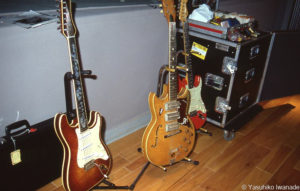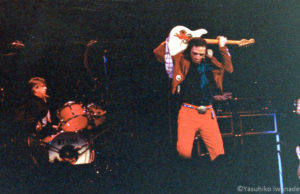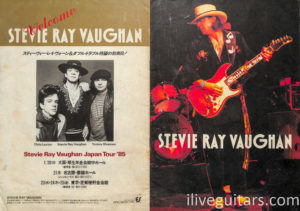In 1979, I traveled to Dallas, Texas to meet Charley Wirz, one of the founders of the Greater Southwest Guitar Show, and to attend the second edition of the show held at North Park Inn. Since I was unfamiliar with the area, Charley graciously took me under his wing and introduced me to the Dallas music scene.
We attended gigs featuring the Fabulous Thunderbirds, Papa John Creach, Anson Funderburgh, and others. One evening, Charley insisted that I see a local guitarist who was not yet signed with a label but was incredibly talented. It turned out to be Stevie, the brother of Jimmy Vaughan whom I had seen perform earlier.
We went to the venue, and Charley introduced me to Stevie. Offstage, Stevie was gentle and polite, but once he took the stage, he became a blazing fire, already showcasing his signature tone. I have some pictures from that time, and I will share them here once I locate them.
In terms of equipment, I remember that Stevie was already utilizing bi-amping. On one occasion, I saw him using a Marshall Club Country combo amp and a small piggyback Fender Tremoluxe amp in parallel. Charley explained to me that Stevie used one for overdrive and sustain, while the other provided a gutsy, non-distorted sound as the core foundation.
This choice of amplifiers made sense to me because that particular model of Marshall wasn’t known for its screaming distortion. Bi-amping allowed Stevie to craft his sound with remarkable clarity while still achieving overdrive. By adjusting the volume of each amplifier’s signal path, he could achieve the perfect blend of sweetness and cutting presence.
I believe Stevie Ray used the Marshall for a gutsy, clean core sound (not heavily distorted) and the Fender for singing sustain. It was a brilliant approach.
During that visit, I even had the opportunity to sit in and play with Stevie, but unfortunately, circumstances prevented me from seizing that chance. However, a few years later, I went back and pleaded for another opportunity, and this time, I got to play with him. It wasn’t just for a few songs—it was a truly remarkable experience, including a rendition of “Little Wing” (thankfully, I knew the chord sequence).
There’s much more to the story that I will share later, but Stevie and I became friends. On one of my trips to the US that extended to Austin, I visited his house in Round Rock, Texas. Apart from engaging in good conversation (I also conducted an interview, which I’ll try to share here at some point), two items stood out among his gear: a vintage Rickenbacker 360 WB (very rare, from the 1960s) and an original UniVibe.
Unfortunately, I didn’t have much knowledge about his Tube Screamers back then, so I can’t provide any details on those.
The photo below was taken at Las Colinas studio a few years later. In the picture, we can see his Hamiltone (with his name on the fingerboard), a Kay Airline, and a fiesta red Stratocaster. That night, I had the opportunity to closely examine his #1 Stratocaster. The action was unbelievably high, and the strings were extremely thick. Stevie had an incredibly strong grip to tame that instrument.
In January 1985, Stevie Ray Vaughn and Double Trouble came to Japan to promote their album “Couldn’t Stand The Weather.”
The schedule was as follows: January 20th at Osaka Kosei Nenkin, January 21st at Nagoya Unryu Hall, and three days of performances in Tokyo on January 23rd, 24th, and 25th. It turned out that both Stevie and I were available on January 24th, so I went to the hotel at the appointed time, where I was able to meet Stevie. His wife, Lenny, was resting in their hotel room, apparently exhausted from the time difference and the regional performances. After that, I was about to leave since Stevie had a dinner with the promoter, but he invited me to join them. Given that there would be people from the promoter’s side and band members, we decided to go separately and meet at the restaurant, which I believe was Tokuju in Shimbashi area.
When I arrived at the restaurant, Stevie and his group had already arrived. Stevie invited me to join his table, but I didn’t want to interfere with the promoter’s work, so I dined at a separate table with my wife and others.
As we were leaving the restaurant, Stevie separated from his staff and came over to me. We walked back to the hotel together, just the two of us, talking along the way. Later, my wife described the scene:
“Stevie Ray Vaughan and Yasuhiko, walking arm in arm and chatting happily in front of me. And it wasn’t in Texas but right in the middle of Tokyo! It was almost like a miracle.”
While we were talking, I noticed that Stevie was carrying something box-shaped with headphones around his neck. I quickly realized that he had the latest cutting-edge product of the time, the first-generation Sony CD Walkman. I was also a Sony enthusiast and gadget lover, always quick to get the latest Walkman models, but I hadn’t yet bought the CD Walkman. Seeing that he had brought it all the way here, I thought Stevie must have been really happy to get it soon after arriving in Japan.
“Wow, that’s amazing! You already have one. What are you listening to?” I asked.
“Wes Montgomery,” Stevie replied, looking very pleased.
For the concert, we had tickets at the will call, but once inside the venue, he invited us to come closer and watch the band from the side of the stage. Offstage, he was a gentle and happy guy, but once he stepped on stage, it was as if his body grew larger, and he played with remarkable authority. I distinctly remember during one song, possibly “Lenny,” he came out and sat on the front edge of the stage, with his legs hanging down and his guitar resting on his lap. In the El Mocambo video, we see him smoking a cigarette, but on that night, he was smoking tobacco in a pipe.

I have some pictures of him playing at Nick’s (Dallas, TX). I will put it up as I find it in my vault…

I have a collection of photos capturing Stevie Ray Vaughan playing at Nick’s in Dallas, TX. I will share them as I uncover them from my vault. Just stumbled upon this particular photo in my vault, although it wasn’t taken at Nick’s—likely in Tokyo instead.
Here, Stevie is holding Charley’s white Stratocaster equipped with Danelectro pickups, and he’s playing it flipped onto his shoulder! From this angle, you can catch a glimpse of the distinctive HULA girl sticker on the back! Prior to this, I had the opportunity to visit Charley’s shop while they were constructing it specifically for Stevie. I believe they were building two guitars; both were pearl white. This photo, taken without a flash, maybe a bit blurry, but I thought it was a cool addition to showcase its rarity.

This is 8 page leaflet Epic / Sony created for SRV Japan tour, handed out at the concert. The cover shows him playing the Hamiltone with his name inlaid across the fingerboard. Back cover shows members, gig dates and venues. They had 5gigs total and 3 were in Tokyo.
Meeting and Parting with Stevie Ray Vaughan
I had always thought I would tell the story of meeting Charley, the owner of Charley’s Guitar in Texas, and shortly thereafter being introduced to the local musician Stevie Ray Vaughan, whom Charley supported, up until sitting in the family section at his funeral. I recall writing a bit about it in the past, but the full story has been too painful to tell, so I have kept it sealed away. However, I have now decided to gradually record that meeting and parting.
The passing of Mr. Charley Wirtz, the founder of the original The Greater Southwest Guitar Show.
I plan to discuss my relationship with Charley in more detail separately.
One day in February 1985, the phone rang at my home in Tokyo. Since mobile phones did not exist at that time, it was common to use the home phone. My wife answered the phone first. It was a long-distance call.
She was responding in English, so I approached quickly to take over the call. My wife, shocked, said that the call was from Stevie Ray and that he was saying, “Charley is dead.” As soon as I took over, Stevie quietly said, “Our friend Charley, is dead.” The subsequent conversation was so painful that I can’t remember it, and we both hung up with few words.
I later learned that Charley had planned to attend the NAMM SHOW (officially named the Winter Music & Sound Market Anaheim in 1985) in Anaheim with friends from his home in Dallas. He had been staying near the convention center and died suddenly at his accommodation. Despite being deeply shocked himself, Stevie Ray took the time to immediately inform me, living several thousand miles away in Japan, about the passing of Charley, whom I had admired like a parent. Even now, I am moved by Stevie Ray’s thoughtfulness.